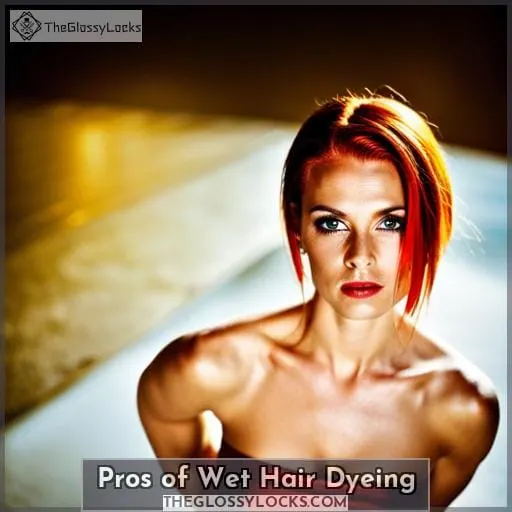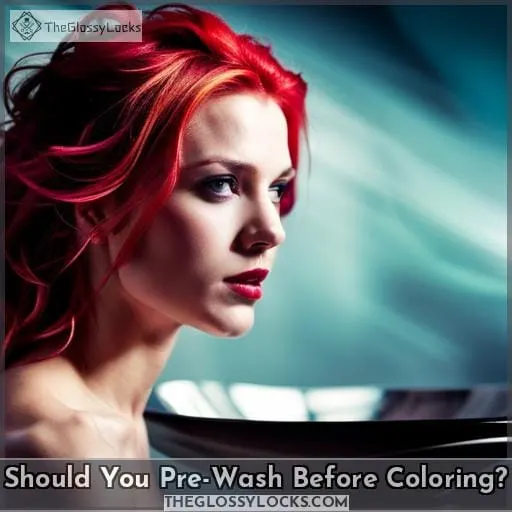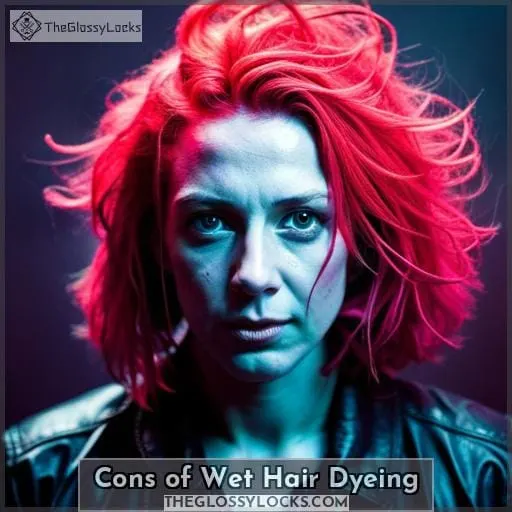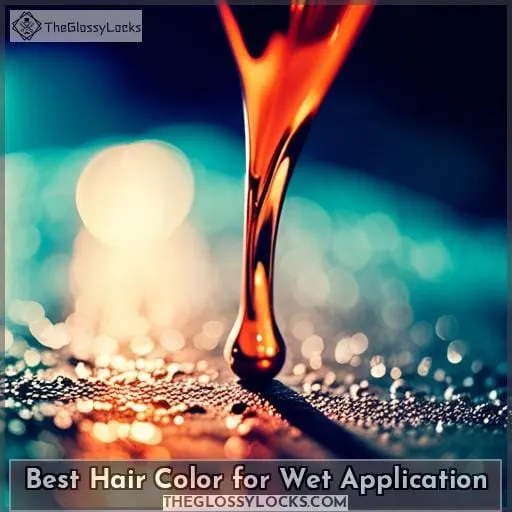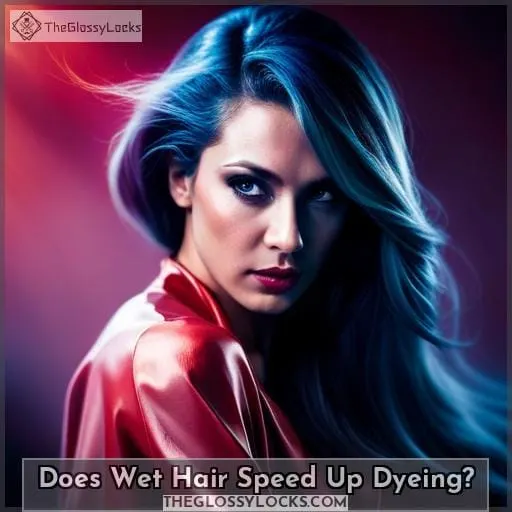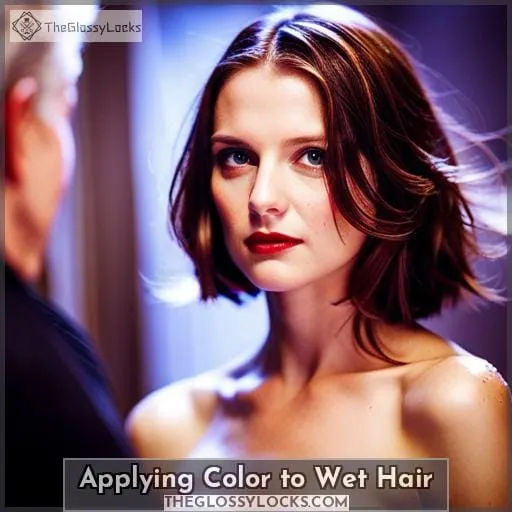This site is supported by our readers. We may earn a commission, at no cost to you, if you purchase through links.
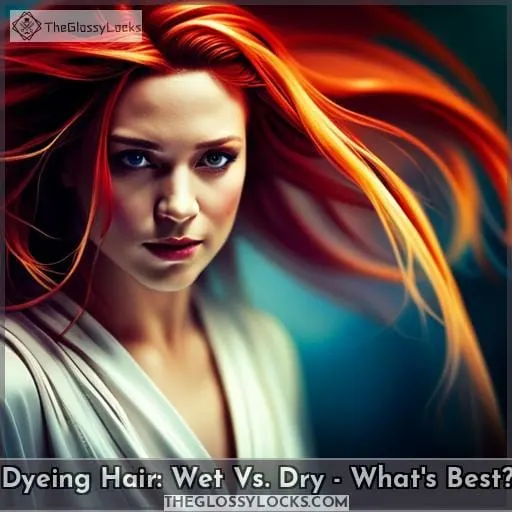
Dive into the pros and cons, the ideal products, and the techniques that ensure your color journey is nothing short of brilliant.
Table Of Contents
- Key Takeaways
- Dyeing Hair: Wet Vs. Dry
- Pros of Wet Hair Dyeing
- Should You Pre-Wash Before Coloring?
- Cons of Wet Hair Dyeing
- Best Hair Color for Wet Application
- Does Wet Hair Speed Up Dyeing?
- Applying Color to Wet Hair
- Frequently Asked Questions (FAQs)
- Does the ambient humidity affect the outcome of dyeing wet hair compared to dry hair?
- Are there specific types of dyes that work better with wet hair, considering hair porosity?
- Can conditioning treatments be used in conjunction with wet hair dyeing without affecting the color outcome?
- How does the application technique differ when dyeing wet hair for temporary versus permanent colors?
- Are there any temperature considerations (hot or cold water) that can impact the efficacy of dyeing wet hair?
- Conclusion
Key Takeaways
- The impact of moisture on color absorption is significant in wet hair dyeing.
- Pros of wet hair dyeing include subtle color changes and enhanced distribution.
- Cons involve potential uneven coloration, dilution affecting retention, and challenges with permanents.
- Optimal for wet application are temporary and semi-permanent dyes with precautions for vibrant results.
Dyeing Hair: Wet Vs. Dry
When coloring your hair, understanding the difference between dyeing it wet versus dry is crucial for achieving the best results.
Wet hair tends to absorb color differently than dry hair due to its increased porosity, impacting the chemical interactions with the dye. While semi-permanent dyes can be applied to damp strands, the benefits of wet hair application are balanced by potential downsides.
Wet application allows subtle color changes and even distribution, especially beneficial for individuals with coarse or thick hair. However, it can lead to uneven coloration and dilution of dye, affecting color retention.
Permanent versus semi-permanent dyeing on wet hair presents challenges due to its vulnerability and limited retention capacity.
Considering different types of hair color, demi-permanent and temporary dyes are suitable for wet application, offering longer-lasting results compared to semi-permanent options. The application process for wet hair involves ensuring dampness, precise coloring methods, and using recommended products like semi-permanent color bowls or specialized masks.
Maintaining hair color vibrancy post-application requires suitable products such as color-enhancing shampoos and conditioners for optimal results.
Pros of Wet Hair Dyeing
When opting between dyeing your hair wet or dry, considering the advantages of wet application might sway your decision.
Wet dyeing offers subtle yet noticeable results while ensuring even color distribution, thanks to the added moisture. It’s a game-changer, especially for textured or coarse hair, requiring less dye and potentially enhancing color saturation.
Subtle Results
Achieve a more subdued shade by dyeing your hair when it’s damp, allowing for a gentler, nuanced result.
Experience:
- Balayage techniques creating soft dimensions.
- Enhanced color saturation for coarse or thick hair.
- Reduced harshness in color for extremely dry strands.
- Subtle toning effects with wet application, especially for porous hair.
Moisture Enhances Color Distribution
Enhance your hair’s color distribution through moisture when dyeing wet.
Moisture’s impact on the dyeing process is significant, as it allows for better color penetration and even distribution.
Wetness dynamics play a crucial role in dye absorption, ensuring that the color spreads evenly throughout your strands.
This results in vibrant and long-lasting hair color that beautifully showcases your personal style.
Reduction in Dye Quantity
To further highlight the advantages of dyeing hair while wet, one major benefit is that it allows for a reduction in the quantity of dye needed. Moisture impact and open cuticles aid color penetration, ensuring consistent dye absorption rates, optimizing application techniques, and minimizing the required dye volume.
Benefits for Hair Texture
For hair texture, wet dyeing enables even color saturation and smoother distribution of the dye, fostering a more cohesive and blended result.
- Moisture Benefits: Wet application adds hydration to the hair, improving its overall condition.
- Texture Enhancement: Wet dyeing helps enhance the texture of coarse or thick hair by ensuring even color saturation.
- Hydration Impact: The moisture from wet application can help manage frizz and add shine to the hair.
- Managing Frizz: Applying dye on wet hair can help tame frizzy strands by providing extra moisture.
Should You Pre-Wash Before Coloring?
Washing your hair right before coloring is pivotal for optimal dye absorption and results. While some may think squeaky-clean hair is the best canvas, freshly washed hair mightn’t hold color as effectively.
Here’s the lowdown: a day or two before your dye session, give your hair a good cleanse with shampoo. This timing strikes the balance, ensuring your scalp isn’t oily yet allowing your hair to retain its natural oils, which actually help protect during the coloring process.
Why skip shampoo right before? Simple. Your hair’s natural oils act as a shield, providing a barrier against the potential harshness of the dye. Plus, these oils aid in retaining moisture, crucial for color absorption and retention.
Think of it as creating the perfect environment for the dye to do its magic. When hair is too clean, the dye mightn’t adhere as effectively, resulting in uneven color or premature fading.
Understanding your hair’s porosity is key here. Pre-dye care involves finding that sweet spot where your hair is clean enough for optimal color absorption but retains enough natural oils for protection and color retention.
It’s the delicate balance between a blank canvas and a shield against color damage.
Cons of Wet Hair Dyeing
Dyeing your hair when wet might sound convenient, but it comes with downsides.
Moisture in wet hair dilutes the dye, leading to less vibrant color and potential unevenness in the result.
Permanent dyes particularly struggle on wet hair, often requiring more touch-ups due to their diminished effectiveness.
Potential Uneven Coloration
When dyeing your hair while wet, you risk potential uneven coloration due to the spreading effect of moisture across the strands during the dye application process.
This moisture impact can lead to variations in color saturation, affecting the precision of application.
Concerns about longevity arise as the diluted dye might contribute to quicker color fading.
Achieving consistent, lasting color on wet hair demands extra caution to avoid the pitfalls of erratic dye distribution.
Dilution of Dye
Excess moisture in wet hair can lead to a notable dilution of the dye during the coloring process, impacting the vibrancy and longevity of the intended color.
- Color Retention: Wet hair’s higher porosity affects dye absorption.
- Hair Porosity: Moisture alters hair’s ability to retain color molecules.
- Chemical Interactions: Water in wet hair can interfere with dye chemistry.
- Color Intensity: Diluted dye results in a less intense color payoff.
Challenges With Permanent Dyes
For those considering dyeing their hair while wet, permanent dyes pose significant challenges due to their formulation and the vulnerability of wet strands.
Challenges With Permanent Dyes
- Risk of Uneven Color
- Limited Absorption
- Impact on Longevity
Wet hair hampers even pigment distribution.
Dye mightn’t penetrate as effectively.
Color longevity affected due to diluted application.
Permanent dyes struggle on wet hair due to uneven coloring, limited absorption, and compromised longevity, making them less suitable for wet hair maintenance, varied coloring techniques, and optimal hair health.
Best Hair Color for Wet Application
To achieve the best results when dyeing your hair while it’s wet, it’s important to choose the most suitable type of hair color.
- Color Absorption: Opt for temporary colors like demi-permanent and semi-permanent dyes. These types of dyes work well on wet hair because they lack ammonia and penetrate into the cuticle, providing longer-lasting results.
- Moisture Impact: Wet hair allows deeper absorption of temporary color into the cuticle due to its open structure. The water also adds moisture, ensuring even distribution of color throughout your strands.
- Application Techniques: When applying dye to wet hair, make sure it’s damp rather than soaking wet to prevent excessive dripping during application. Use gloves and apply using a bowl and brush or directly with gloved hands for even coverage.
By following these precautions and choosing appropriate techniques,
you can enhance both your experience in freedom by experimenting with different looks as well as belonging by understanding which products work best on you.
Additionally,
these tips will help ensure that your new vibrant look lasts longer since
wet application allows faster absorption but may result in diluted colors; thus proper technique requires caution.
always follow product instructions carefully
to maximize longevity
and maintain beautiful colored locks!
Does Wet Hair Speed Up Dyeing?
Wet hair can potentially speed up the dyeing process due to its open cuticle, allowing for faster color absorption.
When your hair is wet, the cuticles on each strand are raised and more receptive to absorbing the dye molecules. This enhanced absorption means that the color saturation can occur more efficiently, resulting in a quicker application process.
The moisture impact of wet hair also plays a role in speeding up dyeing time. Water helps distribute the color evenly throughout your strands, ensuring that every section is covered with precision. Additionally, because wet hair spreads better than dry hair, you may need less dye overall.
However, it’s important to note that not all dyes are suitable for application on wet hair. Some permanent dyes contain stronger chemicals which could lead to chemical sensitivity or damage when applied directly onto damp strands.
Therefore it’s crucial to follow product instructions and recommendations regarding whether they should be used on dry or wet locks.
If you’re opting for at-home coloring with a temporary or semi-permanent dye designed specifically for use on damp tresses like demi-permanent colors mentioned earlier as being best suited; this method allows deeper absorption into the cuticle while minimizing potential harm caused by harsher chemicals present in permanent formulas meant only intended usage conditions such as those found within professional environments where expertise ensures safe practices always prevail during treatments performed by trained professionals who possess both knowledge skill set required performing tasks safely accurately guarantee desired outcome without compromising integrity client’s natural look regardless their personal requirements preferences concerning shade texture length thickness etcetera but please remember before proceeding consult licensed cosmetologist obtain necessary guidance ensure successful results achieved according individual needs desires personal circumstances while maintaining healthy scalp condition managing expectations realistic achievable levels satisfaction thus attaining peace mind knowing have done everything possible achieve optimal appearance beauty enhancing effects sought after achieving sense freedom belonging understanding enhance self-confidence staying true oneself feeling comfortable own skin expression identity unique individuality celebrating life lived fullest embracing adventure journey ahead confidence knowing look best doing so.
Applying Color to Wet Hair
When it comes to applying color to wet hair, there are a few steps you should follow for the best results:
- Make sure your hair is damp but not soaking wet before starting the application process.
- Remove any excess water with a towel to prevent dripping during application.
- Apply your chosen semi or demi-permanent dye according to the instructions provided.
- Cover with a shower cap until it’s time to rinse.
Steps for Application
Your application’s effectiveness while dyeing hair wet hinges on precision and timing. To achieve optimal color retention, it’s crucial to follow the correct steps for applying color to wet hair.
Firstly, ensure that your hair is clean by shampooing before applying semi-permanent or demi-permanent dye to damp strands. Remove excess moisture with a towel and then apply the dye evenly using a bowl and brush or gloved hands.
Follow the instructions provided with your chosen product for processing time before rinsing out thoroughly.
By following these application techniques, you can control moisture levels, saturate the hair with dye effectively, and achieve beautiful results when coloring wet hair.
Recommended Products for Wet Dyeing
For optimal results when coloring damp hair, select products formulated specifically for wet application to enhance color vibrancy and longevity.
- Color Lock Technology: Look for products boasting color-lock technology to ensure your hue stays vibrant for longer periods, even on wet strands.
- Moisture Retention Formula: Choose dyes infused with moisture-retaining ingredients that keep your hair hydrated during the coloring process, preventing excessive drying.
- Precision Control Tools: Utilize precision control tools like applicator brushes or combs designed for wet hair application, ensuring even distribution and targeted coloring.
- Shower-Friendly Options: Seek products explicitly designed for shower application, making the process mess-free and convenient while enhancing color absorption for that perfect hue.
Frequently Asked Questions (FAQs)
Does the ambient humidity affect the outcome of dyeing wet hair compared to dry hair?
Ambient humidity impacts wet hair dyeing, affecting color absorption.
High humidity slows drying, potentially diluting dye and leading to uneven results.
Dry hair ensures precise color uptake, avoiding humidity-related inconsistencies.
Are there specific types of dyes that work better with wet hair, considering hair porosity?
For hair with varying porosity, semi-permanent and demi-permanent dyes work best on wet hair, ensuring deeper absorption. These formulations coat the cuticle gently, delivering more even results and longevity in color.
Can conditioning treatments be used in conjunction with wet hair dyeing without affecting the color outcome?
Yes, conditioning treatments can be used in conjunction with wet hair dyeing without affecting the color outcome.
These treatments provide nourishment and hydration to the hair while the dye penetrates for a vibrant and healthy-looking result.
How does the application technique differ when dyeing wet hair for temporary versus permanent colors?
When it comes to temporary hair color, applying it to wet strands can lead to deeper absorption and longer-lasting results.
However, for permanent colors, dry application ensures precision and avoids potential damage.
Choose wisely!
Are there any temperature considerations (hot or cold water) that can impact the efficacy of dyeing wet hair?
For optimal dye absorption, lukewarm water rinses before dyeing are ideal.
Avoid hot water as it opens the cuticles excessively, leading to diluted color.
Cold water, conversely, seals the cuticles, hindering dye penetration.
Conclusion
Ultimately, the wet or dry debate in hair dyeing reveals intriguing nuances.
While wet application offers subtler transformations and enhanced moisture, it might lead to uneven coloration or diluted results.
Experiment cautiously, considering your hair type and the dye used. Seek professional advice for the best approach.
Embrace the potential benefits of wet dyeing for subtle shifts in hue and improved moisture retention, but proceed mindfully to achieve your desired results in this hair color journey.


